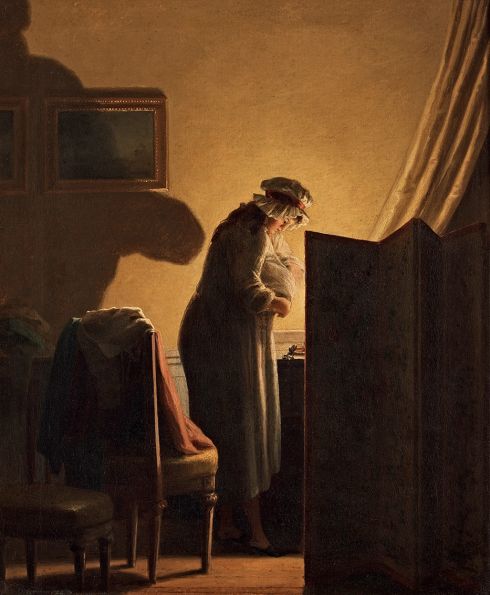Read more
(Väddö, Roslagen, 1732 – Stockholm, 1816)
Woman Catching a Flea by Candlelight
Oil on canvas
51 x 42 cm
Provenance
Stockholm, collection of Harald Bildts (1876–1947), diplomat.
Stockholm, collection of Countess Blanche Bondes (1865–1960).
Passed by inheritance to Count Thord Bondes (1900–1969), general, son of the countess; remained by inheritance in his family.

Little known outside his native Sweden, Pehr Hilleström was the most important genre painter of the Gustavian era; his depictions of the kingdom’s different classes made him the perfect embodiment of Swedish identity at the period of the Enlightenment. Of humble origin, he was the eldest of twelve children and grew up on the island of Väddö, in the eastern province of Roslagen. When the family moved to Stockholm in 1743 he was placed with the landscape painter and interior designer Johan Philip Korn, while becoming at the same time the pupil of Guillaume Taraval and Jean Eric Rehn at the Royal Academy of Fine Arts. Apprenticed to the high-warp weaver Pierre Louis Duru, in charge of textile decoration at the palace, Hilleström devoted his youth to tapestry-making; rapidly excelling in his craft, he was able to successfully complete his master’s works when the latter died.
On a trip to Paris in 1757–1758 to see the Gobelins and Savonnerie manufactories in action, he came upon French painting in the form of Boucher, from whom he took lessons; more important, however, was Chardin, whose class at the Academy he attended after being inspired by his discovery of the latter’s work. However, his career as a painter only began to blossom with the accession to the throne of Gustav III in 1771; Gustav became his first patron and appointed him Court Painter in 1776. This sign of royal favour was noted by the members of the court and the upper middle classes and generated a veritable craze for his work. Adapting Chardin to the Swedish artistic climate, Hilleström filled a gap on a national scene hitherto dominated by landscape, the portrait and ornamental painting. With their novelty and picturesque charm his interiors, theatre scenes and images of craftsmen at work were extraordinarily successful. In 1794 Hilleström was made a professor at the Royal Academy, and became its director in 1810.
Woman Catching a Flea by Candlelight offers nothing new in terms of subject or genre. Derived from Caravaggism, the nocturnal genre scene had met with enormous success in seventeenth-century European painting. The theme of the woman and the flea was rare, but had already been masterfully interpreted by Georges de La Tour in a Tenebrist register (Nancy, Musée des Beaux-Arts), and differently – but no less appealingly – by Giuseppe Maria Crespi (Paris, Musée du Louvre; Florence, Uffizi Gallery). In this work by Hilleström two factors convey the period’s taste for typecasting: the flea and the economic status of the candle point to the social class of the subject, most probably embodied by his wife and favourite model, Ulrica Lode. The work’s interest, though, lies elsewhere. On his return from France Hilleström had made a point of studying Flemish and Dutch painting, and he took the quest for new Luminist effects in an entirely different direction, creating in the process a sub-genre of which he was the sole representative. Drawn to the subtle interplay of artificial lighting, he made highly original use of cast shadows and back-lighting: in this composition, structured by the powerful contrast between the light and the screen that conceals its source, the woman’s shadow takes on astonishing proportions. While Hilleström’s style lacks the sophistication of his French contemporaries, his visual intuitions and plastic inventiveness express a modernity deserving of greater recognition in the history of the European art of his time.
Mehdi Korchane
Shorten
Read more